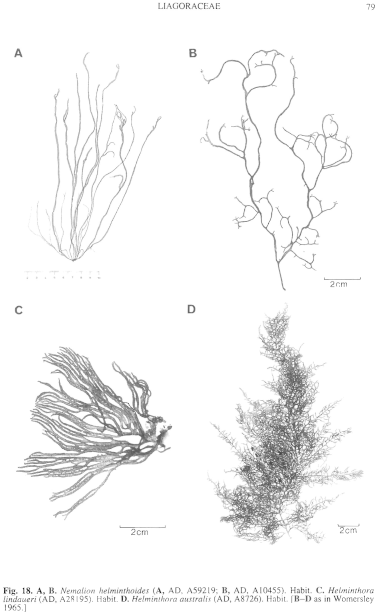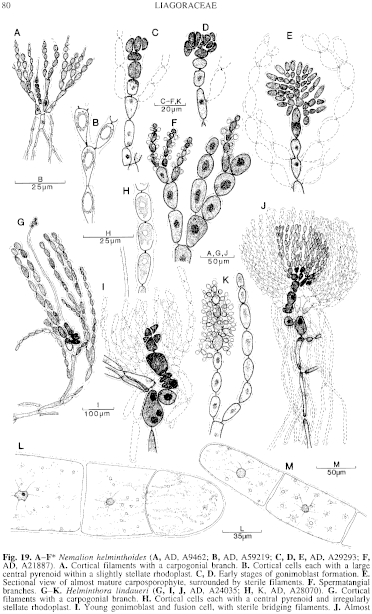|
|
|
|
|
|||||||||||
|
Electronic Flora of South Australia Species Fact Sheet
Phylum Rhodophyta – Class Florideophyceae – Order Nemaliales – Family Liagoraceae
Selected citations: Chapman 1969: 55, fig. 24. Womersley 1965: 459, figs 10–16, p1. 2 fig. 1.
Thallus (gametophyte) (Fig. 18C) brownish purple, 2–10 cm high, with one to several terete axes, subdichotomously branched several times from near the base and often with laterals from the lower parts in older plants, lower axes 1.5–3 mm in diameter, upper 0.5–1 mm in diameter. Holdfast discoid to pulvinate, 2–5 (–12) mm across; epilithic or on crustose coralline algae. Structure multiaxial, with a medulla 0.5–1 mm broad, consisting of a compact mass of relatively slender filaments (5–10 µm in diameter) mixed with slenderer rhizoidal filaments; cortex (Fig. 19G) 200–400 (–500) µm broad, consisting of an inner cortex of subdichotomous filaments of more elongate cells and an outer cortex of often slightly curved filaments, usually 6–10 (–12) µm in diameter, cells ovoid, L/D 2–3 (–4), with slightly smaller terminal cells; rhodoplasts (Fig. 19H) axile, laminate to stellate, each with a central pyrenoid.
Tetrasporophyte unknown.
Reproduction: Sexual thalli dioecious. Carpogonial branches (Fig. 19G) 4-celled, curved, laterally situated below a dichotomy near the middle of the cortex, with the carpogonium dumb-bell shaped. Zygote dividing transversely, the upper cell forming the gonimoblast (Fig. 18I). Carposporophyte compact (Fig. 19J), lying within the outer cortex, 80–150 µm across in surface view, with terminal ovoid carposporangia 10–12 µm long and 5–8 µm broad. Pit-connections of carpogonial branches broadening as the carposporophyte develops, ultimately forming a small fusion cell (Fig. 19J) involving only the carpogonial branch cells. Sterile post-fertilization bridging filaments develop from the two cells of the dichotomy above the supporting cell (Fig. 19I), producing a dense involucre of upright curved filaments around the carposporophyte (Fig. 19J); involucral filaments similar to cortical filaments. Bridging filaments also producing numerous colourless descending rhizoids, forming a prominent mass (Fig. 19J), often slightly twisted, which penetrates the inner cortex to the medulla; rhizoids commonly (200–) 300–400 µm long. Carposporophyte, involucre, and sterile rhizoids remaining as a unit on squashing the thallus. Spermatangia (Fig. 19K) formed on the end 3–6 cells of occasional cortical filaments, each cell cutting off radially (at first on its upper end) several spermatangial initials which form 2–3 spermatangia, each 2–3 µm in diameter.
Type from Pihama, Taranaki, New Zealand (Lindauer 5441 and Alg. Nova-Zel. Exsicc. 284, 30.i.1945); holotype in UC; isotype in AD, A3982.
Selected specimens: Cape du Couedic, Kangaroo I., S. Aust., shaded eulittoral pool (Womersley, 16.i.1965; AD, A28985). Cape Lannes, S. Aust., mid eulittoral (Womersley, 20.xii.1971; AD, A41150 -"Marine Algae of southern Australia" No. 71). Point Danger, Portland, Vic. (Beauglehole, 10.xii.1960; AD, A28195). Lawrence Rock, Portland, Vic., in low rock pools, (Beauglehole, 15.i.1960, AD, A24035). Bridgewater Bay, Vic., upper sublittoral (Womersley, 28.i.1964; AD, A28070). Warrnambool, Vic., (Price, 16.xii.1963; MELU, 1946 and AD, A29026). Bicheno, Tas., lower eulittoral (Womersley, 4.xi.1982; AD, A56454).
Distribution: New Zealand.
Cape du Couedic, Kangaroo I., S. Aust., to Warrnambool, Vic., and Bicheno, Tasmania.
Taxonomic notes: Helminthora lindaueri usually grows on Corallina or crustose coralline algae just above low tide level, subject to moderate to strong wave wash. It is well marked by its long cortical filaments, extensive development of post-fertilization rhizoids penetrating the inner cortex, and distinctive spermatangial branches.
In thallus form H. lindaueri closely resembles H. furcellata (Reinbold) Martin from South Africa (Martin 1947) but differs in the longer cortical filaments, the arrangement of spermatangia, and the greater development of down-growing rhizoids from the post-fertilization sterile filaments.
References:
CHAPMAN, V.J. (1969). The marine algae of New Zealand. Part III: Rhodophyceae. Issue 1: Bangiophycidae and Florideophycidae (Némalionales, Bonnemaisoniales, Gélidiales). (Cramer: Germany.)
DESIKACHARY, T.V. (1955). On a Helminthora from New Zealand. Amer. J. Bot. 42, 126–131.
MARTIN, M.T. (1947). Some South African Rhodophyceae. II. Helminthora furcellata (Reinbold apud Tyson), comb. nov. Trans. R. Soc. S. Africa 31, 371–379, Plate 12.
WOMERSLEY, H.B.S. (1965). The Helminthocladiaceae (Rhodophyta) of southern Australia. Aust. J. Bot. 13, 451–487, Plates 1–7.
The Marine Benthic Flora of Southern Australia Part IIIA complete list of references.
Publication:
Womersley, H.B.S. (14 January, 1994)
The Marine Benthic Flora of Southern Australia
Rhodophyta. Part IIIA, Bangiophyceae and Florideophyceae (to Gigartinales)
Reproduced with permission from The Marine Benthic Flora of Southern Australia Part IIIA 1994, by H.B.S. Womersley. Australian Biological Resources Study, Canberra. Copyright Commonwealth of Australia.
Illustrations in Womersley Part IIIA, 1994: FIGS 18C, 19 G–K.

Figure 18 enlarge
Fig. 18. A, B. Nemalion helminthoides (A, AD, A59219; B, AD, A10455). Habit. C. Helminthora lindaueri (AD, A28195). Habit. D. Helminthora australis (AD, A8726). Habit. [B–D as in Womersley 1965.]

Figure 19 enlarge
Fig. 19. A–F* Nemalion helminthoides (A, AD, A9462; B, AD, A59219; C, D, E, AD, A29293; F, AD, A21887). A. Cortical filaments with a carpogonial branch. B. Cortical cells each with a large central pyrenoid within a slightly stellate rhodoplast. C, D. Early stages of gonimoblast formation. E. Sectional view of almost mature carposporophyte, surrounded by sterile filaments. F. Spermatangial branches. G–K. Helminthora lindaueri (G, I, J, AD, A24035; H, K, AD, A28070). G. Cortical filaments with a carpogonial branch. H. Cortical cells each with a central pyrenoid and irregularly stellate rhodoplast. I. Young gonimoblast and fusion cell, with sterile bridging filaments. J. Almost mature carposporophyte with sterile involucral filaments and descending rhizoids. K. Spermatangial branch. L. Camontagnea oxyclada (AD, A61772). Apical and subapical cells of an indeterminate branch, with rhodoplasts (with pyrenoids) and a central nucleus. M. Camontagnea hirsuta (AD, A27746). Apical and subapical cells of an indeterminate branch, with rhodoplasts (with pyrenoids) and a central nucleus. [A, C–G, I–K after Womersley 1965.]
* In the following drawings of Liagoraceae, sterile filaments associated with carposporophyte development are shown with broken lines.

|
Email Contact: State Herbarium of South Australia |

|